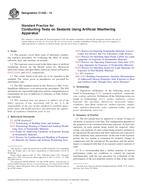Potrebujeme váš súhlas na využitie jednotlivých dát, aby sa vám okrem iného mohli ukazovať informácie týkajúce sa vašich záujmov. Súhlas udelíte kliknutím na tlačidlo „OK“.
ASTM C1442-14
Standard Practice for Conducting Tests on Sealants Using Artificial Weathering Apparatus
Automaticky preložený názov:
Štandardné praktiky pre vykonávanie skúšok na tmely Použitie umelého starnutia Prístroje
NORMA vydaná dňa 15.7.2014
Informácie o norme:
Označenie normy: ASTM C1442-14
Poznámka: NEPLATNÁ
Dátum vydania normy: 15.7.2014
Kód tovaru: NS-11310
Počet strán: 6
Približná hmotnosť: 18 g (0.04 libier)
Krajina: Americká technická norma
Kategória: Technické normy ASTM
Kategórie - podobné normy:
Anotácia textu normy ASTM C1442-14 :
Keywords:
accelerated weathering, actinic radiation, artificial accelerated weathering, durability, exposure, fluorescent UV lamps, light, open flame carbon arc, sealant, temperature, ultraviolet, UV-radiation, weathering, xenon arc, ICS Number Code 91.100.50 (Binders. Sealing materials)
Doplňujúce informácie
| Significance and Use | ||||||||||||||||||
|
5.1 This practice determines the effects of actinic radiation, elevated temperature, and moisture on sealants and their constituents under controlled laboratory artificial weather test conditions. 5.2 When conducting exposures in devices which use laboratory light sources, it is important to consider 5.3 Because of differences in the spectral power distributions of the exposure sources (xenon arc, fluorescent UV lamps, and open flame carbon arc), as well as other conditions used in the three types of laboratory weathering tests, including temperature, type and amount of moisture, and test cycles, these three procedures may not result in the same performance ranking or types of failure modes of sealants. Further, different exposure durations may be required for testing the weathering performance of sealants by the three types of exposures. Comparisons should not be made of the relative stability of sealants exposed in the different types of apparatus. 5.4 Variations in results may be expected when operating conditions are varied within the accepted limits of this practice. Therefore, all test results using this practice must be accompanied by a report of the specific operating conditions as required in Section 10. Refer to Practice G151 for detailed information on the caveats applicable to use of results obtained according to this practice. 5.5 No laboratory exposure test can be specified as a total simulation of actual use conditions in outdoor environments. The relative durability of materials in actual use conditions can vary in different locations because of differences in UV radiation, time of wetness, relative humidity, temperature, pollutants, and other factors. Results obtained from these laboratory accelerated exposures can be considered as representative of actual use exposures only when the degree of rank correlation has been established for the specific materials being tested and when the failure mode is the same. Exposure of a similar material of known outdoor performance, a control, along with the test specimens provides for evaluation in terms of relative durability under the test conditions, which also greatly improves the agreement in test results among different laboratories. 5.6 The acceleration factor relating the exposure time in a laboratory accelerated test to exposure time outdoors required to produce equivalent degradation is material dependent and can be significantly different for each material and for different formulations of the same material. Therefore, the acceleration factor determined for one material cannot be assumed to be applicable to other materials. 5.7 Results of this procedure will depend on the care that is taken to operate the equipment according to Practices G152, G154, and G155. Significant factors include regulation of the line voltage, freedom from salt or other deposits from water, temperature control, humidity control, where applicable, condition and age of the burners and filters in xenon arc equipment, and age of lamps in fluorescent UV equipment. Note 1: Additional information on sources of variability and
on strategies for addressing variability in the design, execution
and data analysis of laboratory accelerated exposure tests is found
in Guide G141.
|
||||||||||||||||||
| 1. Scope | ||||||||||||||||||
|
1.1 This practice covers three types of laboratory weathering exposure procedures for evaluating the effect of actinic radiation, heat, and moisture on sealants. 1.2 The exposure sources used in the three types of artificial weathering devices are the filtered xenon arc, fluorescent ultraviolet lamps, and open flame carbon arc based on Practices G155, G154, and G152, respectively. 1.3 The values stated in SI units are to be regarded as the standard. The values given in parentheses are provided for information only. 1.4 The ISO standard related to this Practice is ISO 11431. Significant differences exist between the procedures. The ISO specimens are exposed through glass and are elongated prior to examination for loss of adhesion or cohesion, or both, following exposure. 1.5 This standard does not purport to address all of the safety concerns, if any, associated with its use. It is the responsibility of the user of this standard to establish appropriate safety and health practices and determine the applicability of regulatory limitations prior to use. |
||||||||||||||||||
| 2. Referenced Documents | ||||||||||||||||||
|




 Cookies
Cookies
